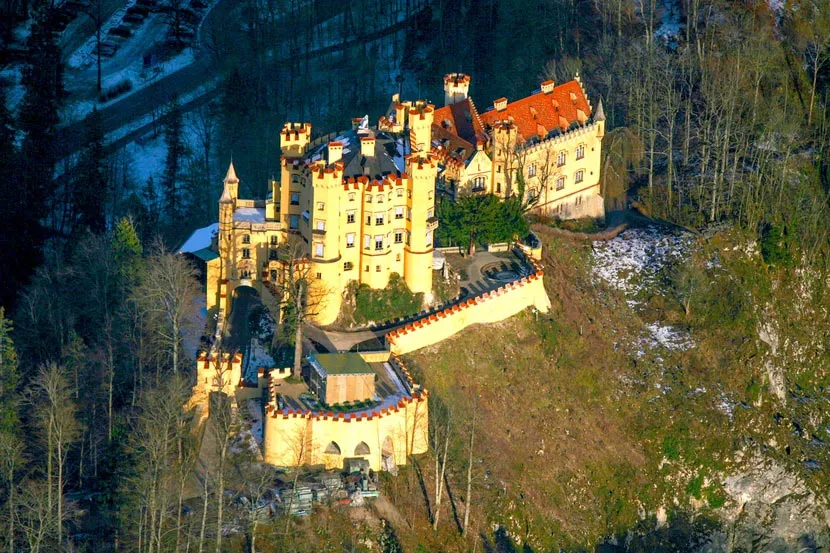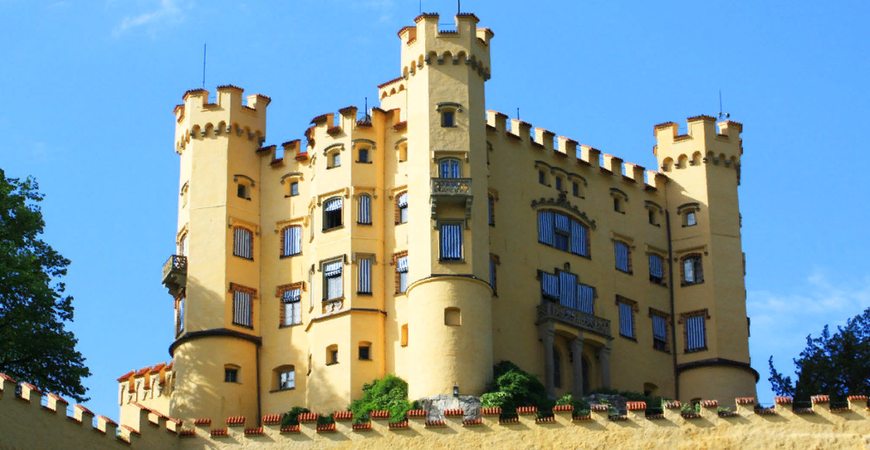 |
| Hohenschwangau Castle |
Almost every tourist who comes to Germany to get acquainted with the sights of the country dreams of visiting this amazing place, which at one time was the favorite residence of the Bavarian kings . Even the very name of the Hohenschwangau Castle, which literally translates into Russian as "high swan land", cannot fail to interest the guest of Bavaria, Germany.
If you look at the photographs of Hohenschwangau Castle, taken from a bird's eye view, it may seem that the castle has grown in the middle of a dense forest, and there is not a single path that would lead to an architectural masterpiece.
 |
| Hohenschwangau Castle |
Naturally, this is not the case, Hohenschwangau Castle, like Neuschwanstein located directly opposite it, is considered one of the main points on tourist routes: numerous excursions are constantly organized to them, and some guests of Bavaria, using tourist avenues, get to architectural masterpieces on their own. Therefore, there are paths, and even roads with high-quality asphalt surfaces, they are simply hidden by architects among the trees in such a way that visitors get the feeling that they are in a fabulous place, where there is no place for the hustle and bustle of large cities.
 |
| Hohenschwangau Castle |
By and large, Hohenschwangau Castle was built with the goal of allowing members of royal families to be closer to amazing nature, to enjoy beautiful forests and a magnificent, crystal-clear lake, located near two castles. Of particular interest among tourists is the fact that in Hohenschwangau most of his, alas, short life was spent by the famous "fairy king", on whose orders the Neuschwanstein Castle was built.
 |
| Hohenschwangau Castle |
The “fairytale king” Ludwig II, despite his oddities and special worldview, which was not to the liking of the rulers of Bavaria, to say the least, managed to leave behind a huge number of architectural masterpieces. Most of them, including Neuschwanstein, the construction of which the young monarch watched from the balcony of Hohenschwangau, were inspired by German fairy tales and... the music of the great Richard Wagner.
However, this story, the end of which the modern police would call "dark", deserves special attention, however, like the history of the construction of Hohenschwangau Castle, which is currently on the balance sheet of the legendary Wittelsbach dynasty.
 |
| Hohenschwangau Castle |
Hohenschwangau Castle - Construction History
If you carefully study the ancient documents found by archaeologists and historians, you can draw a certain conclusion: even before the appearance of Hohenschwangau Castle, a fortress stood in its place . It was built specifically for the great knights of Schwangau in the 12th century, although it would be more correct to say that the exact date of its construction is unknown; it, called Schwanstein, is only first mentioned in chronicles dating back to the 12th century. All knights of Schwangau belonged to two dynasties: Hohenstaufen and Welf.
 |
| Hohenschwangau Castle |
By the way, one of the princes of the Hohenstaufen dynasty went down in history as an ardent opponent of the Pope himself, for which, by the way, he was cursed by the Catholic Church, and more than once. The Schwangau fortress was not only their residence, but, as can be seen from history, a defensive fortification capable of withstanding a long siege. True, all two families broke off in the 16th century, and the fortress became an unnecessary building for anyone. During the invasion of Napoleon's troops, the Schwanstein fortification was turned into ruins.
 |
| Hohenschwangau Castle |
The king of great Bavaria, Maximilian II, while still being the crown prince, somehow arrived in this amazing land of forests and lakes. He walked to the ruins and, according to his contemporaries, was struck by the beauty that opened from the ruins of the fortress. Without thinking twice, Maximilian II buys the ruins of the fortress and the adjacent territory. The purchase of the ruins cost the crown prince 7,000 guilders, which did not hit his budget hard. Almost immediately after the deal, the future king of Bavaria ordered to restore some of the fortress premises and build new ones.
 |
| Hohenschwangau Castle |
The castle was built six years after the acquisition of the fortress. The architect Domenico Cavallo managed to develop a plan for a building in the neo-Gothic style, which surprisingly naturally blended into the surrounding landscape. Many modern architects, looking at Hohenschwangau, succumbing to emotions, enthusiastically say that the castle seemed to have grown on a rock at the whim of nature itself . Indeed, almost nothing remained of the gloomy fortress: in its place a unique castle with towers, painted in warm yellow, appeared.
 |
| Hohenschwangau Castle |
Numerous balconies and turrets that could not be used for defense made Cavallo's creation truly fabulous. Father Maximilian II, who was distinguished by restraint in the manifestation of feelings, seeing the building that was erected by the order of his son, shouted enthusiastically: “This is a fairy tale! This is a real castle of fairies! ". By the way, the proud and majestic swan became the symbol of Hohenschwangau, which even in the 12th century flaunted on the coat of arms of the Schwangau dynasty.
 |
| Hohenschwangau Castle |
Hohenschwangau - Home of the "fairy king"
After Maximilian II departed to another world, one of his sons, Ludwig II, ascended the throne, who later received the nickname "fabulous" among the people. He loved this castle, because within its walls he could indulge in dreams of fabulous countries and the kind creatures inhabiting them. He did not marry, so his mother was always with him, who loved her son without memory, who, according to numerous documents drawn up at that time, suffered from a mental disorder.
 |
| Hohenschwangau Castle |
Whether it is true or not, it is no longer possible to prove, but there is no evidence that Ludwig II was prone to aggression or despondency. All his strangeness lay only in the fact that he wanted to give himself and his people a fairy tale: on his order, the construction of numerous castles began, the appearance of which was inspired by the monarch by legends about the exploits of the Bavarian knights and their victories over evil forces. As mentioned above, one of the castles, built by order of Ludwig II, stands opposite Hohenschwangau and is called Neuschwanstein.
 |
| Hohenschwangau Castle |
It was from the amazing beauty of the Hohenschwangau balconies that the young Bavarian king watched the construction of the "new swan stone" , which is translated into German as Neuschwanstein, almost all day. The death of King Ludwig II put an end to the erection of magnificent castles and palaces in Bavaria, each of which undoubtedly deserves special attention.
The very death of the monarch, who was removed from the throne and placed under the supervision of a psychiatrist, is covered with a thick veil of secrecy. It is no longer possible to investigate his murder (this is what historians believe): the king, according to his uncle's version, drowned with a psychiatrist in a beautiful lake near Hohenschwangau.
 |
| Hohenschwangau Castle |
Hohenschwangau Castle - A fairy tale for tourists
In our age of technological progress, when life in megacities causes a lot of stress and disappointment, being in Hohenschwangau Castle is akin to traveling to a fairy tale or to a country inhabited only by kind mythical creatures. In this country, you can enjoy a picturesque forest, a fairytale castle and a beautiful lake, where proud swans swim.
 |
| Hohenschwangau Castle |
Of particular interest is not only the neo-Gothic style of the castle itself, but also its interior decoration. In the living room of Queen Mary, you can see amazing paintings telling about the fate of the Schwanstein Fortress, its proud knights from the Hohenstaufen and Welf dynasties. In this room there is a portrait of Martin Luther on the wall, as well as paintings depicting the most ordinary people: grooms, servants who once served in the castle.
By the way, the “fairy king” most often spent his time on the second floor in his mother’s living room: looking at the paintings of Medieval knights, he was transported into the past and created his own reality. On the second floor there is also the legendary piano, on which the great composer Wagner played at the request of the "strange king".
 |
| Hohenschwangau Castle |
If you try to highlight one of the most beautiful premises of the Hohenschwangau Castle (which is quite difficult), then it will be, perhaps, the Banquet Hall , which is often called in many tourist avenues as the "hall of knights" or "hall of heroes". There is a legendary "table with pictures" written according to the "Nibelungen saga". In addition, the walls are decorated with episodes of the Viking sagas. It was this Banquet Hall or “Hall of Heroes” that became the place where Ludwig II had the idea to build Neuschwanstein Castle.
 |
| Hohenschwangau Castle |
Surprisingly, the Hohenschwangau Castle was spared the world wars. Probably, it is precisely because of this that it is the most visited place in Bavaria, because each "stone" here is original and did not have to be restored from the ruins, as, for example, in the case of the Charlottenburg Palace . According to official figures, more than 350,000 people come to the village of Schwangau every year to see the fabulous Hohenschwangau with their own eyes.
A tourist who comes to the land of Bavarian forests and lakes should be aware that there is a shop in one of the many annexes of the castle: there you can buy unique souvenirs and gifts for loved ones, made mostly by hand by German craftsmen.
 |
| Hohenschwangau Castle |
If you manage to linger and stay in the vicinity of the village after dusk, you can take amazing night photos of Hohenschwangau Castle. Looking at them, one can really believe in the "fantastic origin" of the castle: between the mountains overgrown with majestic fir trees, the castle glows, which, as if by an absurd accident, ended up in our world, because its place is in a fairy tale, by the way, in the same fairy tale as castle Neuschwanstein.